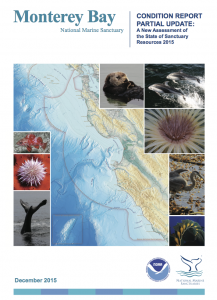 Monterey Bay National Marine Sanctuary is a federal marine protected area encompassing over 6,000 square miles in the United States. Within the boundaries of the sanctuary is a rich array of habitats, from rugged rocky shores and lush kelp forests to an underwater mountain, and one of the largest underwater canyons in North America. These habitats abound with life, from tiny microscopic plants to enormous blue whales. The sanctuary is home to a diversity of species including marine mammals, seabirds and shorebirds, sea turtles, fishes, invertebrates and marine algae.
Monterey Bay National Marine Sanctuary is a federal marine protected area encompassing over 6,000 square miles in the United States. Within the boundaries of the sanctuary is a rich array of habitats, from rugged rocky shores and lush kelp forests to an underwater mountain, and one of the largest underwater canyons in North America. These habitats abound with life, from tiny microscopic plants to enormous blue whales. The sanctuary is home to a diversity of species including marine mammals, seabirds and shorebirds, sea turtles, fishes, invertebrates and marine algae.
Access the Condition Report Update to hear about new information gathered since 2009.
This document provides a partial update to Monterey Bay National Marine Sanctuary’s 2009 Condition Report. The 2009 report provided a summary of resources in the National Oceanic and Atmospheric Administration’s Monterey Bay National Marine Sanctuary (MBNMS or sanctuary), pressures on those resources, current conditions and trends, and management responses to reduce or mitigate human pressures. Specifically, the State of Sanctuary Resources section of the 2009 Condition Report presented responses to a set of 17 questions posed to all sanctuaries (see Appendix A). These responses provided information on the status and trends of water quality, habitat, living resources and maritime archaeological resources, and the human activities that affect them. These 17 questions were completed for three marine environments: (1.) estuarine, (2.) nearshore and (3.) offshore. The 2009 report can be downloaded from the Office of National Marine Sanctuaries website1.
This report provides an updated assessment of the health of the sanctuary in the State of Sanctuary Resources section. Sanctuary staff, with input from regional scientific experts, re-evaluated status and trend ratings for 162of the questions. Each question was re-evaluated for accuracy and completeness, given new data sets, published literature and expert opinion that have become available since 2009. In most cases, new information and updated narratives are provided for each question, and many include new status and trend ratings. Trend ratings are generally based on trends since 2009. This re-evaluation was completed for the three aforementioned marine environments: (1.) estuarine, (2.) nearshore and (3.) offshore. Furthermore, a fourth marine environment, seamount, was evaluated for the first time in this update due to the addition of Davidson Seamount Management Zone to the sanctuary in November 2008 (Figure 1).
In order to address the set of 16 questions, sanctuary staff consulted with outside experts familiar with the resources and with knowledge of previous and current scientific investigations in the sanctuary. Evaluations of status and trends are based on interpretation of quantitative and, when necessary, qualitative assessments, and the observations of scientists, managers and users. The ratings reflect the collective interpretation of the status of local issues of concern among sanctuary system staff and outside experts based on their knowledge and perception of local problems. The final ratings were determined by sanctuary staff. This report has been peer reviewed and complies with the White House Office of Management and Budget’s peer review standards, as outlined in the Final Information Quality Bulletin for Peer Review.
This is the second effort to comprehensively describe the status and trends of resources at Monterey Bay National Marine Sanctuary. The report helps identify gaps in current monitoring efforts, as well as causal factors that may require monitoring and potential remediation in the years to come. The data discussed will not only enable resource managers and stakeholders to acknowledge prior changes in resource status, but will also provide guidance for future management challenges imposed by issues such as increasing coastal populations and climate change. This updated condition report also serves as a supporting document for the revision of the Monterey Bay National Marine Sanctuary Management Plan and will help inform constituents who wish to participate in that process.